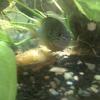I'm going to set up a 20 gallon long for my 1 male flagfish. I might eventually get 1 or 2 females for him, but I'm not sure yet. If I do get the females, what should I do to breed them? This aquarium will be without a light, but will get some sunlight from a window. I will have a screen lid on the aquarium. Will filtration be necessary if I only have 1-3 flagfish? It will be densely planted. I can post pictures when I'm done setting it up. Finally got a camera.

florida flagfish 20 gallon
#3

Posted 14 April 2016 - 09:07 PM
While I will defer to Nick's insights and expertise, I will also add my experience breeding Flagfish. I have worked with multiple colonies of this species with multiple spawns each time. Dense plants without filtration should be okay based on the proposed density if you do regular water changes. From my experience a few fry survived when I left the eggs in the tank, however I had improved success by using a spawning mop and either water incubating or damp incubating the eggs - more fry with water incubating but still had over a dozen fry hatch when damp incubating. Good luck!
#4

Posted 15 April 2016 - 05:45 AM
There was a splash of sarcasm in my response--but I mirror your insight. They aren't quite as explosive as a group of gambusia, but will certainly breed in the presence of water. I will also add that dense ground cover would increase fry survival (if left with the parents). I found that the larvae spend a few weeks scooting just above the sand. Microworms made a great food item for those first couple of weeks. They stay on top of the sand for a good while allowing the fry to find them.
A dense mat of floating plants, like coontail, makes a great nursery for juveniles after they get a little older. I was able to raise a small colony in a 20g starting with 1.2 adults. I think the biggest predators on newly hatched fry were older siblings who could still get into the areas where the fry were. I never witnessed the adults hunting their offspring. Once a fry was ~1/2", it would freely swim mid-water near the parents.
#5

Posted 15 April 2016 - 10:45 AM
I've recently started breeding a trio I brought back from Florida a couple of years ago. I have a male and two females in a bare 15 long with two spawning mops, and some pvc pipes for the females to hide in if they need to. The temperature is about 76 degrees. I maintain the tank with about a tablespoon of instant ocean in the water. I've collected several batches of eggs. I lost the first batch of fry, probably from making the water too acidic when I fed them vinegar eels. A few more fry hatched yesterday, and I'll try starting them on green water.
My experience with native killies is that it's hard to get many fry unless you're resigned to picking mops. Maybe if you only had 3 adult flag fish to a tank with a lot of surface area, course gravel, and dense java moss/hornwort growth, you could colony breed them. The course gravel would allow the eggs to fall into the crevices and provide lots of hiding places for the fry to hide from the adults.
They definitely seem to lay more eggs after a big water change.
http://www.sonnysfishroom.com
You never know what you're going to find, or where you're going to find it. So keep looking.
#9

Posted 22 April 2016 - 08:10 AM
Just try to give them lots of hiding places so they can get away from the male if they need to.
Here's a video of some of my fish.
https://www.facebook...461279330347617
http://www.sonnysfishroom.com
You never know what you're going to find, or where you're going to find it. So keep looking.
#10

Posted 22 April 2016 - 06:02 PM
i raised a good batch in a 3ft plastic kiddie pool with about 3-4 inches of water, afew rocks, a lot of uncleaned plants, and a couple of sponge filters, shallow water supposededly lets the fry get to the surface, fill their swim bladders and develop better, rocks give females a place to hide as does the3 ft diameter, plants hide and supply food for fry
Reply to this topic
1 user(s) are reading this topic
0 members, 1 guests, 0 anonymous users










